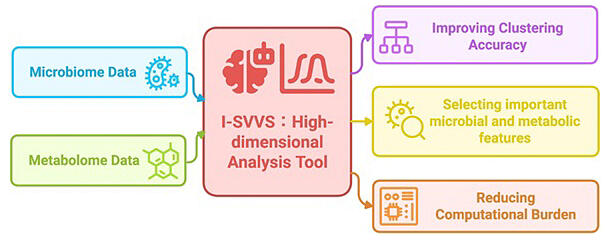Professor Hiroyoshi Iwata and his colleagues from the Graduate School of Agricultural and Life Sciences at the University of Tokyo have developed a new method called integrative stochastic variational variable selection (I-SVVS). This method elucidates the relationship between microbes and metabolites by integrating and clustering data from microbiomes and metabolomes found near host organisms, such as in plant rhizosphere soil and animal intestines. This enables a deeper understanding of the interactions between microbiomes and metabolites in diverse host organisms and is expected to contribute to the development of agriculture, medicine, and environmental science. Their study was published in Briefings in Bioinformatics.

Provided by the University of Tokyo
Multi-omics microbiome data refers to integrated data from various omics technologies, such as metagenomes (genetic information representing microbial species) and metabolomes (metabolites), used to understand the functions and interactions of microbial communities. While this data contains large amounts of information, it is characterized by low density of individual data points and strong correlations between multiple variables (multicollinearity), requiring advanced computational methods for proper analysis.
The I-SVVS developed by the research group is the first method specifically designed for analyzing high-dimensional microbiome data. I-SVVS adopts a variable selection framework based on stochastic variational inference, applying an infinite Dirichlet multinomial mixture model for microbiome data and an infinite Gaussian mixture model for metabolome data, thereby improving computational efficiency and analysis accuracy. Furthermore, it identifies the minimal set of features containing the most important information from the vast number of features in the data, enabling high-precision classification (clustering) and discovery of microbe-metabolite relationships.
Experiments using three datasets from soybeans, mice, and humans showed higher accuracy and faster processing capability than conventional analysis methods (iClusterPlus and Clusternomics) in all cases. Particularly, for the soybean dataset (377 samples, 16,943 microbial species, 265 metabolites), I-SVVS enabled more accurate and rapid analysis. It identified important microbial groups associated with soybean growth and revealed microbe-metabolite relationships under various environmental conditions.
These results demonstrate that I-SVVS has the potential to significantly advance multi-omics microbiome research. Until now, it has been difficult to clearly capture the relationship between microbial functions and host organism health and growth, and analyzing complex data has required significant time and effort. However, by utilizing I-SVVS, it becomes possible to more accurately understand how microbes interact with host organisms, promoting growth or causing disease.
From this it is possible to analyze in detail how soil microbes promote plant growth or how gut bacteria affect human health. This has the potential to lead to improved crop yields and the promotion of sustainable agriculture in the agricultural field, and to the development of disease prevention and treatment methods utilizing gut bacteria in the medical field. Additionally, in environmental research, I-SVVS could contribute to nature conservation and climate change responses by providing a deeper understanding of the role microbes play in ecosystem balance.
Going forward, utilizing I-SVVS is expected to enable deeper elucidation of microbe-host relationships and applications across a wide range of fields including agriculture, medicine, and environmental science.
Journal Information
Publication: Briefings in Bioinformatics
Title: I-SVVS: integrative stochastic variational variable selection to explore joint patterns of multi-omics microbiome data
DOI: 10.1093/bib/bbaf132
This article has been translated by JST with permission from The Science News Ltd. (https://sci-news.co.jp/). Unauthorized reproduction of the article and photographs is prohibited.




